The recent measles outbreak at Disneyland has put an increased spotlight on parents who haven't vaccinated their children, whether for personal beliefs or medical reasons.
Closer to home, a Bard College student tested positive for the disease shortly after leaving New York's busy Penn Station, and University of Virginia said earlier this week that a case of mumps was confirmed on campus.
Vaccination rates vary by region and community. But those rates also vary from D.C. and Maryland to Virginia, according to 2013 data from the Centers for Disease Control.
So how do the states (and D.C.) stack up?
The state with the highest rate of MMR vaccination was New Hampshire, but D.C. was a very close second: 96.2 percent of kids in the District ages 19-35 months had received at least one vaccine for measles, mumps and rubella (MMR) as of 2013, with an error margin of +/- 3.1 percent.
Maryland ranked 8th, with 95.3 percent of kids having received at least one MMR vaccine (error margin +/- 4.4 percent).
Virginia, on the other hand, ranked toward the bottom of the list, with 88.6 percent of kids getting at least one MMR vaccine (error margin +/- 7 percent). The commonwealth ranked 45th out of the 50 states plus the District.
Local
Washington, D.C., Maryland and Virginia local news, events and information
The three states with the lowest rate of MMR vaccination are Ohio, Colorado and West Virginia.
The data comes from the CDC's National Immunization Survey, which had a sample size of about 30,000 children. Nationally, about 91.9 percent of kids have received the MMR vaccine, but the CDC said about one child in 12 in the U.S. is not getting their first dose on time.
About 102 people from 14 states were reported to have measles from Jan. 1 to Jan. 30, the CDC said. Most of these cases are linked to the Disneyland outbreak.



